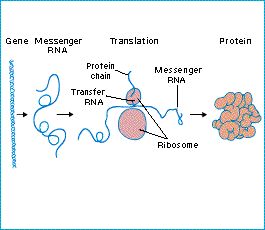Molecular and Mendelian Genetics - What are the building blocks of life

How are proteins made?
Proteins are made up of particular sequences of amino acids. A protein's exact sequence of amino acids determines its nature. Hemoglobin, for example, is made up of two a-globin molecules, which are 141 amino acids long in humans, and two Ŗ-globins, which are 144 amino acids long; insulin has another sequence of 51 amino acids. Hemoglobin binds oxygen in the blood, whereas insulin stimulates cells (particularly muscle cells, and others) to absorb glucose from the blood. The different behavior of hemoglobin and insulin are caused by the chemical properties of their different amino acids, arranged in their characteristic sequence.
For many purposes it is not grievously wrong to describe DNA as made up of genes (and non-coding regions), and genes as coding for proteins.
However, the idea that one gene encodes for one protein is a simplification and it is misleading to regard genetic material as some sort of blueprint for an organismís phenotype.
Richard Dawkins discusses the value of the blueprint metaphor.
Figure: the transfer of information in a cell.
| Next |



